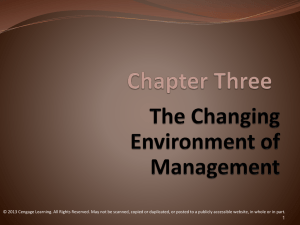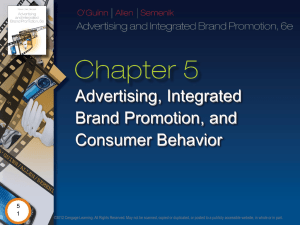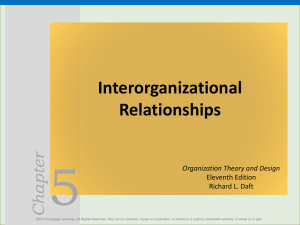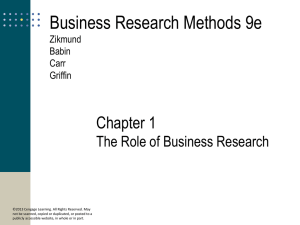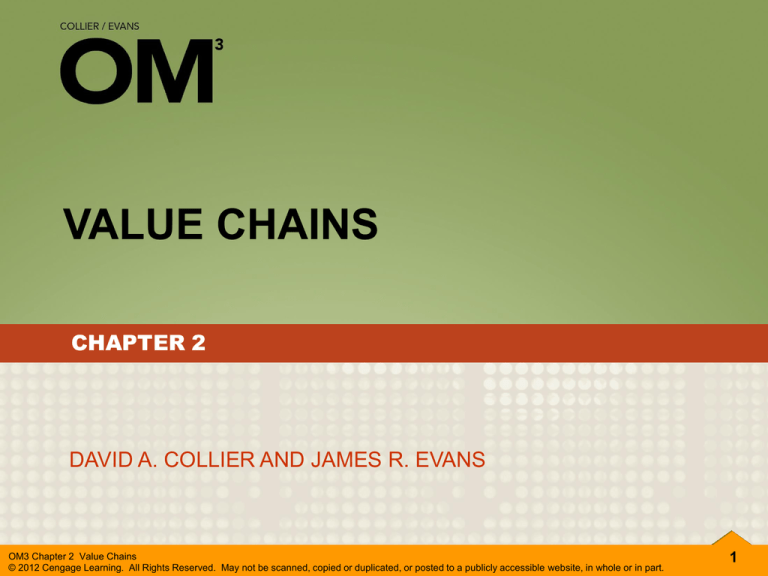
VALUE CHAINS
CHAPTER 2
DAVID A. COLLIER AND JAMES R. EVANS
OM3 Chapter 2 Value Chains
© 2012 Cengage Learning. All Rights Reserved. May not be scanned, copied or duplicated, or posted to a publicly accessible website, in whole or in part.
1
CHAPTER 2
VALUE CHAINS
LO1 Explain the concept of value and how it can be
increased.
LO2 Describe a value chain and the two major
perspectives that characterize it.
LO3 Explain outsourcing and vertical integration in
value chains.
LO4 Explain offshoring and issues that managers must
consider in offshoring decisions.
LO5 Identify important issues associated with value
chains in a global business environment.
LO6 Describe how sustainability plays an important role
in value chains.
OM3 Chapter 2 Value Chains
© 2012 Cengage Learning. All Rights Reserved. May not be scanned, copied or duplicated, or posted to a publicly accessible website, in whole or in part.
2
CHAPTER 2
VALUE CHAINS
A
pple has mastered the art of blending physical goods
with services to create value for its customers. Think iPod
+ iTunes, iPhone + apps, iPad +videos; well, you get the
picture. Apple was recognized as having "an intoxicating
mix of brilliant industrial design, transcendent software
interfaces and consumable goods that are purely digital…
The mechanical and financial benefits of this approach
include extremely high inventory turns, minimal material or
capacity limitations to growth, and excellent margins.”
When Apple introduced the 3G iPhone in July of 2008, there
were plenty of phones available in Apple stores. In just
three days, Apple sold 1 million iPhones.
OM3 Chapter 2 Value Chains
© 2012 Cengage Learning. All Rights Reserved. May not be scanned, copied or duplicated, or posted to a publicly accessible website, in whole or in part.
3
CHAPTER 2
VALUE CHAINS
The processes by which the physical goods are produced
and delivered, called the supply chain—that is,
purchasing raw materials, manufacturing the phones, and
distributing them to retail outlets—worked marvelously.
However, one part of the service side of Apple’s business
did not work as smoothly. During those first few launch
days, iTunes was not able to deal with the huge number
of demands for phone activations that came from 21
different countries, overwhelming call center and server
capacity, resulting in many frustrated customers.
OM3 Chapter 2 Value Chains
© 2012 Cengage Learning. All Rights Reserved. May not be scanned, copied or duplicated, or posted to a publicly accessible website, in whole or in part.
4
CHAPTER 2
VALUE CHAINS
What do you think?
Cite some other
examples in which digital
content has been
combined with a physical
good. How do you see
the digital revolution
changing the nature of
physical goods in the
future?
OM3 Chapter 2 Value Chains
© 2012 Cengage Learning. All Rights Reserved. May not be scanned, copied or duplicated, or posted to a publicly accessible website, in whole or in part.
5
CHAPTER 2
VALUE CHAINS
Value and Supply Chains
• A value chain is a network of facilities and
processes that describes the flow of goods,
services, information, and financial transactions
from suppliers through the facilities and processes
that create goods and services and deliver them
to customers.
• A supply chain is the portion of the value chain
that focuses primarily on the physical movement
of goods and materials, and supporting flows of
information and financial transactions through the
supply, production, and distribution processes.
OM3 Chapter 2 Value Chains
© 2012 Cengage Learning. All Rights Reserved. May not be scanned, copied or duplicated, or posted to a publicly accessible website, in whole or in part.
6
CHAPTER 2
VALUE CHAINS
The Concept of Value
•
The underlying purpose of every organization
is to provide value to its customer and
stakeholders.
• Value is the perception of the benefits
associated with a good, service, or bundle of
goods and services (i.e., the customer benefit
package) in relation to what buyers are
willing to pay for them.
OM3 Chapter 2 Value Chains
© 2012 Cengage Learning. All Rights Reserved. May not be scanned, copied or duplicated, or posted to a publicly accessible website, in whole or in part.
7
Porter Model (1985)
CHAPTER 2
OM3 Chapter 2 Value Chains
© 2012 Cengage Learning. All Rights Reserved. May not be scanned, copied or duplicated, or posted to a publicly accessible website, in whole or in part.
VALUE CHAINS
8
CHAPTER 2
VALUE CHAINS
Creating “Value” for Shareholders [Lee, 2012]:
• Creating Value = Shareholders’ wealth maximization
• Value = shareholders’ wealth
• Shareholders’ wealth = stock price
• Stock price = firm value / # of outstanding common
•
•
•
stocks
Firm value = profit (EBIT) / cost of capital
Profit = total revenue – total cost
Conclusion: To increase value for shareholders, we
have to create “value” in all activities inside of the firm
(Primary & Support Activities), and in the Industry
value chain, meaning we have to increase revenue &
decrease cost every where possible.
OM3 Chapter 2 Value Chains
© 2012 Cengage Learning. All Rights Reserved. May not be scanned, copied or duplicated, or posted to a publicly accessible website, in whole or in part.
9
CHAPTER 2
Value =
VALUE CHAINS
Perceived benefits
Price (cost) to the customer
If the value ratio is high, the good or service is perceived
favorably by customers, and the organization providing it is
more likely to be successful. To increase value, an
organization must:
(a) increase perceived benefits while holding price or cost
constant,
(b) increase perceived benefits while reducing price or cost, or
(c) decrease price or cost while holding perceived benefits
constant.
OM3 Chapter 2 Value Chains
© 2012 Cengage Learning. All Rights Reserved. May not be scanned, copied or duplicated, or posted to a publicly accessible website, in whole or in part.
10
CHAPTER 2
VALUE CHAINS
Value Chain Paradigms and Perspectives
• Input-Output Model: A value chain begins
with suppliers who provide inputs that are
transformed into value-added goods and
services through processes that are supported
by resources such as equipment and facilities,
labor, money, and information. These goods
and services are delivered or provided to
customers and targeted market segments.
OM3 Chapter 2 Value Chains
© 2012 Cengage Learning. All Rights Reserved. May not be scanned, copied or duplicated, or posted to a publicly accessible website, in whole or in part.
11
CHAPTER 2
VALUE CHAINS
Exhibit 2.1 An Input-Output Perspective of a Value Chain
OM3 Chapter 2 Value Chains
© 2012 Cengage Learning. All Rights Reserved. May not be scanned, copied or duplicated, or posted to a publicly accessible website, in whole or in part.
12
CHAPTER 2
VALUE CHAINS
Exhibit 2.2 Examples of Goods-Producing and Service-Providing Value Chains
OM3 Chapter 2 Value Chains
© 2012 Cengage Learning. All Rights Reserved. May not be scanned, copied or duplicated, or posted to a publicly accessible website, in whole or in part.
13
CHAPTER 2
VALUE CHAINS
Buhrke Industries, Inc. Value Chain
•
Buhrke Industries Inc., located in Arlington Heights,
Illinois, provides stamped metal parts to many
industries, including automotive, appliance, computer,
electronics, hardware, house wares, power tools,
medical, and telecommunications.
• Buhrke’s objective is to be a customer’s best total-value
producer with on-time delivery, fewer rejects, and
high-quality stampings. However, the company goes
beyond manufacturing goods; it prides itself in
providing the best service available as part of its
customer value chain.
OM3 Chapter 2 Value Chains
© 2012 Cengage Learning. All Rights Reserved. May not be scanned, copied or duplicated, or posted to a publicly accessible website, in whole or in part.
14
CHAPTER 2
VALUE CHAINS
Exhibit 2.3 The Value Chain at Buhrke Industries
Source: Buhrke Industries
company web site
OM3 Chapter 2 Value Chains
© 2012 Cengage Learning. All Rights Reserved. May not be scanned, copied or duplicated, or posted to a publicly accessible website, in whole or in part.
15
CHAPTER 2
VALUE CHAINS
Buhrke Industries, Inc. Value Chain
•
Service is more than delivering a product
on-time. It’s also partnering with customers
by providing personalized service for fast,
accurate response; customized engineering
designs to meet customer needs; preventive
maintenance systems to ensure high machine
uptime; experienced, highly trained, long-term
employees; and troubleshooting by a
knowledgeable sales staff.
OM3 Chapter 2 Value Chains
© 2012 Cengage Learning. All Rights Reserved. May not be scanned, copied or duplicated, or posted to a publicly accessible website, in whole or in part.
16
CHAPTER 2
VALUE CHAINS
Value Chain Paradigms and Perspectives
•
Pre- and Postproduction Services
Perspective: Pre- and postproduction services
complete the ownership cycle for the good or
service. Pre-production services are focused on
“gaining a customer.” Postproduction services
focus on “keeping the customer.” This view of
the value chain emphasizes the notion that
service is a critical component of traditional
manufacturing processes.
OM3 Chapter 2 Value Chains
© 2012 Cengage Learning. All Rights Reserved. May not be scanned, copied or duplicated, or posted to a publicly accessible website, in whole or in part.
17
CHAPTER 2
VALUE CHAINS
Exhibit 2.4 Pre- and Post-Service View of the Value Chain
OM3 Chapter 2 Value Chains
© 2012 Cengage Learning. All Rights Reserved. May not be scanned, copied or duplicated, or posted to a publicly accessible website, in whole or in part.
18
CHAPTER 2
OM3 Chapter 2 Value Chains
© 2012 Cengage Learning. All Rights Reserved. May not be scanned, copied or duplicated, or posted to a publicly accessible website, in whole or in part.
VALUE CHAINS
19
CHAPTER 2
VALUE CHAINS
Nestle—A Service View of a Business
•
•
•
Nestle defines its business initially from a
physical goods viewpoint; later from a service
perspective.
The results were greatly increased Nestle coffee
sales, new revenue opportunities, and much
stronger profits.
Nestle’s service vision of their business required
a completely new service and logistical value
chain capability.
OM3 Chapter 2 Value Chains
© 2012 Cengage Learning. All Rights Reserved. May not be scanned, copied or duplicated, or posted to a publicly accessible website, in whole or in part.
20
CHAPTER 2
VALUE CHAINS
Value and Supply Chains
A supply chain is the portion of the value chain
that focuses primarily on the physical movement
of goods and materials, and supporting flows of
information and financial transactions through the
supply, production, and distribution processes.
Many organizations use the terms “value chain”
and “supply chain” interchangeably; however, we
differentiate these two terms in this book.
OM3 Chapter 2 Value Chains
© 2012 Cengage Learning. All Rights Reserved. May not be scanned, copied or duplicated, or posted to a publicly accessible website, in whole or in part.
21
CHAPTER 2
VALUE CHAINS
Value and Supply Chains
A value chain is broader in scope than a supply
chain, and encompasses all pre- and
postproduction services (see Exhibit 2.3) to create
and deliver the entire customer benefit package.
A value chain views an organization from the
customer’s perspective—the integration of goods
and services to create value—while a supply
chain is more internally-focused on the creation
of physical goods.
OM3 Chapter 2 Value Chains
© 2012 Cengage Learning. All Rights Reserved. May not be scanned, copied or duplicated, or posted to a publicly accessible website, in whole or in part.
22
CHAPTER 2
VALUE CHAINS
Exhibit 2.4 Pre- and Post-Service View of the Value Chain
OM3 Chapter 2 Value Chains
© 2012 Cengage Learning. All Rights Reserved. May not be scanned, copied or duplicated, or posted to a publicly accessible website, in whole or in part.
23
CHAPTER 2
VALUE CHAINS
Exhibit 2.5 A Value Chain Model of Dell, Inc.
OM3 Chapter 2 Value Chains
© 2012 Cengage Learning. All Rights Reserved. May not be scanned, copied or duplicated, or posted to a publicly accessible website, in whole or in part.
24
CHAPTER 2
VALUE CHAINS
Value Chain Decisions
The operational structure of a value chain is
the configuration of resources such as suppliers,
factories, warehouses, distributors, technical
support centers, engineering design and sales
offices, and communication links.
Value chains may be centralized or
decentralized.
OM3 Chapter 2 Value Chains
© 2012 Cengage Learning. All Rights Reserved. May not be scanned, copied or duplicated, or posted to a publicly accessible website, in whole or in part.
25
CHAPTER 2
VALUE CHAINS
Outsourcing and Vertical Integration
• Vertical integration refers to the process of
acquiring and consolidating elements of a value
chain to achieve more control.
• Backward integration refers to acquiring
capabilities toward suppliers, while forward
integration refers to acquiring capabilities
toward distribution or even customers.
• Outsourcing is the process of having suppliers
provide goods and services that were
previously provided internally.
OM3 Chapter 2 Value Chains
© 2012 Cengage Learning. All Rights Reserved. May not be scanned, copied or duplicated, or posted to a publicly accessible website, in whole or in part.
26
CHAPTER 2
VALUE CHAINS
Three Waves of Outsourcing
1. Outsourcing goods-producing jobs, such as computer
components and electronics from the U.S. in many
industries several decades ago.
2. Outsourcing simple service work, such as standard
credit card processing, billing and other forms of
transaction processing, and software development.
3. Outsourcing skilled knowledge work, such as
engineering design, architectural plans, call centers,
and computer chip design.
OM3 Chapter 2 Value Chains
© 2012 Cengage Learning. All Rights Reserved. May not be scanned, copied or duplicated, or posted to a publicly accessible website, in whole or in part.
27
Outsourcing Equilibrium Model [Collier & Evans, 2012]
CHAPTER 2
VALUE CHAINS
The Economics of Outsourcing
VC1 = Variable cost/unit if produced
VC2 = Variable cost/unit if outsourced
FC = Fixed costs associated with producing the part
Q = Quantity produced (volume)
Total cost of production = (VC1)Q + FC
Total cost of outsourcing = (VC2) Q
Find the breakeven point: (VC2)Q = (VC1)Q + FC
Q* =
FC
VC2 − VC1
[2.1]
OM3 Chapter 2 Value Chains
© 2012 Cengage Learning. All Rights Reserved. May not be scanned, copied or duplicated, or posted to a publicly accessible website, in whole or in part.
28
Outsourcing Equilibrium Model [Collier & Evans, 2012]
CHAPTER 2
VALUE CHAINS
Interpretation of the Results:
• If a firm’s anticipated volume < Q* (break-even
quantity), the firm should go for the outsourcing
decision.
• If the anticipated volume > Q*, the firm can afford inhouse operation.
OM3 Chapter 2 Value Chains
© 2012 Cengage Learning. All Rights Reserved. May not be scanned, copied or duplicated, or posted to a publicly accessible website, in whole or in part.
29
CHAPTER 2
VALUE CHAINS
Solved Problem—In-House versus Outsource
Suppose that a manufacturer needs to produce a
custom aluminum housing for a special customer order.
Because it currently does not have the equipment
necessary to make the housing, it would have to acquire
machines and tooling at a fixed cost (net of salvage
value after the project is completed) of $250,000. The
variable cost of production is estimated to be $20 per
unit. The company can outsource the housing to a
metal fabricator at a cost of $35 per unit. The customer
order is for 12,000 units. What should they do?
OM3 Chapter 2 Value Chains
© 2012 Cengage Learning. All Rights Reserved. May not be scanned, copied or duplicated, or posted to a publicly accessible website, in whole or in part.
30
CHAPTER 2
VALUE CHAINS
Solution
VC1 = Variable cost/unit if produced = $20
VC2 = Variable cost/unit if outsourced = $35
FC = fixed costs associated with producing the part = $250,000
Q = quantity produced
Using Equation 2.1 we obtain:
Q = 250,000/($35 - $20) = 16,667
In this case, because the customer order is for only 12,000
units, which is less than the break-even point, the least cost
decision is to outsource the component.
OM3 Chapter 2 Value Chains
© 2012 Cengage Learning. All Rights Reserved. May not be scanned, copied or duplicated, or posted to a publicly accessible website, in whole or in part.
31
CHAPTER 2
VALUE CHAINS
Outsourcing in 1980s - Present [Lee, 2012]
• Theoretically, VC2 was supposed to be higher than VC1. In 1980s,
four small countries in Asia (a.k.a. four tigers) presented VC2 that
was even lower than VC1.
• Outsourcing Equilibrium Model tells us that we will never get Q*
when VC2 < VC1, for the two lines will not cross each other.
•To maintain economic sustainability, U.S. firms had to choose
“outsourcing” to the four tigers. Otherwise, the U.S. firms would
lose competitive advantage in the global markets.
• In 1990s, the four tigers became rich & democracy with labor
union, and could no longer offer low VC2. .
• China filled the vacuum.
• The labor cost in China is increasing, and now China is beginning to
outsource to other countries – Vietnam, Bangladesh, etc.
OM3 Chapter 2 Value Chains
© 2012 Cengage Learning. All Rights Reserved. May not be scanned, copied or duplicated, or posted to a publicly accessible website, in whole or in part.
32
CHAPTER 2
VALUE CHAINS
Managerial Implications [Lee, 2012]
• When a firm makes a decision to outsource its operations, the
firm faces violent opposition from labor union, community,
politicians, customers, etc.
• It is a manager like you who should take responsibility to explain
to them, and gain their support on the corporate decision.
• One way is to present scientific evidence using the Outsourcing
Equilibrium Model [Collier & Evans, 2012].
• Show them the data & graph which illustrate that VC2 < VC1,
which will lead to a failure to reach the break even quantity (Q*)
indefinitely because VC2 and VC1 will never cross each other, and
thus no equilibrium (= Q*) can be made.
OM3 Chapter 2 Value Chains
© 2012 Cengage Learning. All Rights Reserved. May not be scanned, copied or duplicated, or posted to a publicly accessible website, in whole or in part.
33
CHAPTER 2
VALUE CHAINS
Value chain integration is the process
of managing information, physical goods,
and services to ensure their availability at
the right place, at the right time, at the
right cost, at the right quantity, and with
the highest attention to quality.
OM3 Chapter 2 Value Chains
© 2012 Cengage Learning. All Rights Reserved. May not be scanned, copied or duplicated, or posted to a publicly accessible website, in whole or in part.
34
CHAPTER 2
VALUE CHAINS
Value chain integration in manufacturing
•
•
•
Consolidating information systems among suppliers,
factories, distributors, and customers.
Managing the supply chain and scheduling factories.
Studying new ways to use technology.
Value chain integration in services
•
•
•
Third-party integrators for the leisure and travel industry
(e.g., Orbitz, and Travelocity).
Information networks provided by third-party information
technology integrators.
Third-party integrators that manage patient billing and
hospital inventories.
OM3 Chapter 2 Value Chains
© 2012 Cengage Learning. All Rights Reserved. May not be scanned, copied or duplicated, or posted to a publicly accessible website, in whole or in part.
35
CHAPTER 2
VALUE CHAINS
Offshoring is the building, acquiring, or
moving of process capabilities from a
domestic location to another country
location while maintaining ownership and
control.
OM3 Chapter 2 Value Chains
© 2012 Cengage Learning. All Rights Reserved. May not be scanned, copied or duplicated, or posted to a publicly accessible website, in whole or in part.
36
CHAPTER 2
VALUE CHAINS
Exhibit 2.6 Things to Consider When Making Offshore Decisions
OM3 Chapter 2 Value Chains
© 2012 Cengage Learning. All Rights Reserved. May not be scanned, copied or duplicated, or posted to a publicly accessible website, in whole or in part.
37
CHAPTER 2
VALUE CHAINS
Value Chains in a Global Business Environment
A multinational enterprise is an organization that
sources, markets, and produces its goods and
services in several countries to minimize costs, and
to maximize profit, customer satisfaction, and social
welfare.
OM3 Chapter 2 Value Chains
© 2012 Cengage Learning. All Rights Reserved. May not be scanned, copied or duplicated, or posted to a publicly accessible website, in whole or in part.
38
CHAPTER 2
VALUE CHAINS
Challenges Facing Multinational Enterprises
1. How to design a value chain to meet the slower growth
of industrialized countries and more rapid growth of
emerging economies.
2. Where to locate manufacturing and distribution facilities
around the globe to capitalize on value chain efficiencies
and improve customer value.
3. What performance metrics to use in making critical value
chain decisions.
4. How to decide if partnerships should be developed with
competitors to share engineering, manufacturing, or
distribution technology and knowledge.
OM3 Chapter 2 Value Chains
© 2012 Cengage Learning. All Rights Reserved. May not be scanned, copied or duplicated, or posted to a publicly accessible website, in whole or in part.
39
CHAPTER 2
VALUE CHAINS
Rocky Brands, Inc.
•
•
•
Rocky Brands (www.rockyboots.com) headquartered in
Nelsonville, Ohio, manufactures rugged leather shoes for
hiking and camping.
Rocky Brands began making boots in 1932 as the
William Brooks Shoe Company with an average wage
rate of 28 cents per hour. In the 1960s, Rocky Brands
were 100% “Made in America.” In 1960, more than 95
percent of all shoes sold in America were made in
America.
Timberland, Wolverine, and Rocky are popular
brand names for this shoe market segment.
OM3 Chapter 2 Value Chains
© 2012 Cengage Learning. All Rights Reserved. May not be scanned, copied or duplicated, or posted to a publicly accessible website, in whole or in part.
40
CHAPTER 2
VALUE CHAINS
Rocky Brands, Inc.
The principal characteristics of this global value chain:
1. Leather is produced in Australia and then shipped
to the Dominican Republic.
2. Outsoles are purchased in China and shipped to Puerto Rico.
3. Gor-Tex fabric waterproofing materials are made in the United
States.
4. Shoe uppers are cut and stitched in the Dominican Republic,
and then shipped to Puerto Rico.
5. Final shoe assembly is done at the Puerto Rico factory.
6. The finished boots are packed and shipped to the warehouse
in Nelsonville, Ohio.
7. Customer orders are filled and shipped to individual stores and
contract customers from Nelsonville.
OM3 Chapter 2 Value Chains
© 2012 Cengage Learning. All Rights Reserved. May not be scanned, copied or duplicated, or posted to a publicly accessible website, in whole or in part.
41
CHAPTER 2
VALUE CHAINS
Exhibit 2.7 Rocky Brands, Inc. Value Chain
OM3 Chapter 2 Value Chains
© 2012 Cengage Learning. All Rights Reserved. May not be scanned, copied or duplicated, or posted to a publicly accessible website, in whole or in part.
42
CHAPTER 2
VALUE CHAINS
Global Challenges
•
•
•
Profit margins are only about 2 percent on sales of over
$100 million, while Timberland sales top $1 billion and
have a 9 percent profit margin.
After seventy years in Nelsonville, the main factory closed
in 2002. At that time, local labor costs were about $11 per
hour without benefits, while in Puerto Rico the hourly rate
was $6; in the Dominican Republic, $1.25; and in China,
40 cents.
The price of boots continues to decline globally from
roughly $95 a pair to $85, and is heading toward $75. The
grandson of the founder of Rocky Brands said, “We’ve got
to get there, or we're not going to be able to compete.”
OM3 Chapter 2 Value Chains
© 2012 Cengage Learning. All Rights Reserved. May not be scanned, copied or duplicated, or posted to a publicly accessible website, in whole or in part.
43
CHAPTER 2
VALUE CHAINS
Issues for Managing Global Value Chains
•
Global value chains face higher levels of risk and
uncertainty, requiring more inventory and day-to-day
monitoring to prevent product shortages. Workforce
disruptions, such as labor strikes and government
turmoil in foreign countries, can create inventory
shortages and disrupting surges in orders.
•
Transportation is more complex in global value chains.
For example, tracing global shipments normally involves
more than one mode of transportation and foreign
company.
OM3 Chapter 2 Value Chains
© 2012 Cengage Learning. All Rights Reserved. May not be scanned, copied or duplicated, or posted to a publicly accessible website, in whole or in part.
44
CHAPTER 2
VALUE CHAINS
Issues for Managing Global Value Chains
•
The transportation infrastructure may vary considerably
in foreign countries. The coast of China, for example,
enjoys much better transportation, distribution, and
retail infrastructures than the vast interior of the
country.
• Global purchasing can be a difficult process to manage
when sources of supply, regional economies, and even
governments change. Daily changes in international
currencies necessitate careful planning and in the case
of commodities, consideration of futures contracts.
OM3 Chapter 2 Value Chains
© 2012 Cengage Learning. All Rights Reserved. May not be scanned, copied or duplicated, or posted to a publicly accessible website, in whole or in part.
45
CHAPTER 2
VALUE CHAINS
Issues for Managing Global Value Chains
•
International purchasing can lead to disputes and legal
challenges relating to such things as price fixing and
quality defects.
• To extend the firm’s value chain to other nations requires
an understanding of national cultures and practices.
•
Privatizing companies and property is another form of
major changes in global trade and regulatory issues.
•
The pre-planning, response, and recovery from natural or
man-made disasters—often called Disaster or Emergency
Management—is another important part of value chain
management.
OM3 Chapter 2 Value Chains
© 2012 Cengage Learning. All Rights Reserved. May not be scanned, copied or duplicated, or posted to a publicly accessible website, in whole or in part.
46
CHAPTER 2
OM3 Chapter 2 Value Chains
© 2012 Cengage Learning. All Rights Reserved. May not be scanned, copied or duplicated, or posted to a publicly accessible website, in whole or in part.
VALUE CHAINS
47
CHAPTER 2
VALUE CHAINS
Sustainable Value Chains
•
•
•
•
The terms green operations, green manufacturing,
and green practices are often used to describe
sustainability activities that involve operations and the
value chain.
Sustainability improves the organization’s perception
among consumers, and improves the bottom line through
reduced costs.
Sustainable practices can lead to increased revenues. For
example, organizations that emit greenhouse gases like
factories and electrical utilities may one day buy and sell
carbon credits in a commodities-type stock market.
Many customers favor products and services that are
designed and produced in a sustainable way.
OM3 Chapter 2 Value Chains
© 2012 Cengage Learning. All Rights Reserved. May not be scanned, copied or duplicated, or posted to a publicly accessible website, in whole or in part.
48
CHAPTER 2
VALUE CHAINS
Sustainable Value Chains
OM practices for environmental sustainability:
• Designing goods and services using recyclable and
environmentally-friendly materials.
• Remanufacturing.
• Designing facilities and using equipment that conserve
energy.
• Using electronic media and technology to reduce paper
and fuel.
• Using transportation modes that minimize costs and
carbon output.
• Cleaning and reusing water used for manufacturing.
OM3 Chapter 2 Value Chains
© 2012 Cengage Learning. All Rights Reserved. May not be scanned, copied or duplicated, or posted to a publicly accessible website, in whole or in part.
49
CHAPTER 2
VALUE CHAINS
Save a Tree—and Much More
One issue of the Quadrangle—a University of Kentucky alumni College of
Engineering magazine—noted that, “This issue was printed with vegetable
ink on 12,125 pounds of paper made with 100% post consumer recycled
fiber. The resulting environmental savings are:
•
•
•
•
•
41,954 lbs of wood—a total of 145 trees that supply enough oxygen for 73
people annually;
53,050 gallons of water—enough water to take 3,084 eight-minute showers;
101 million BTUs of energy—enough energy to power an average American
household for 406 days;
12,781 lbs of emissions—carbon sequestered by 153 tree seedlings grown
for 10 years;
6,812 lbs. of solid waste—a total of 235 thirty-two gallon garbage cans of
waste.”
This paper publication was produced twice each year up until 2010, when it
became a web-based publication only.
OM3 Chapter 2 Value Chains
© 2012 Cengage Learning. All Rights Reserved. May not be scanned, copied or duplicated, or posted to a publicly accessible website, in whole or in part.
50
CHAPTER 2
VALUE CHAINS
Bookmaster Case Study
1. Draw the “bricks and mortar” process stages by which hardcopy
books are created, distributed, and sold in retail stores. How
does each player in the value chain make money?
2. Draw the process stages for creating and downloading an eBook
today. How does each player in this electronic/digital value
chain make money?
3. Compare and contrast the value chain design and structure in
the previous two questions from customer and management
viewpoints. What are the advantages/disadvantages to each
value chain design?
4. What is the role of operations in each of these value chain
designs and structures?
5. What other criteria and issues are important in critiquing these
two different value chain designs?
OM3 Chapter 2 Value Chains
© 2012 Cengage Learning. All Rights Reserved. May not be scanned, copied or duplicated, or posted to a publicly accessible website, in whole or in part.
51



